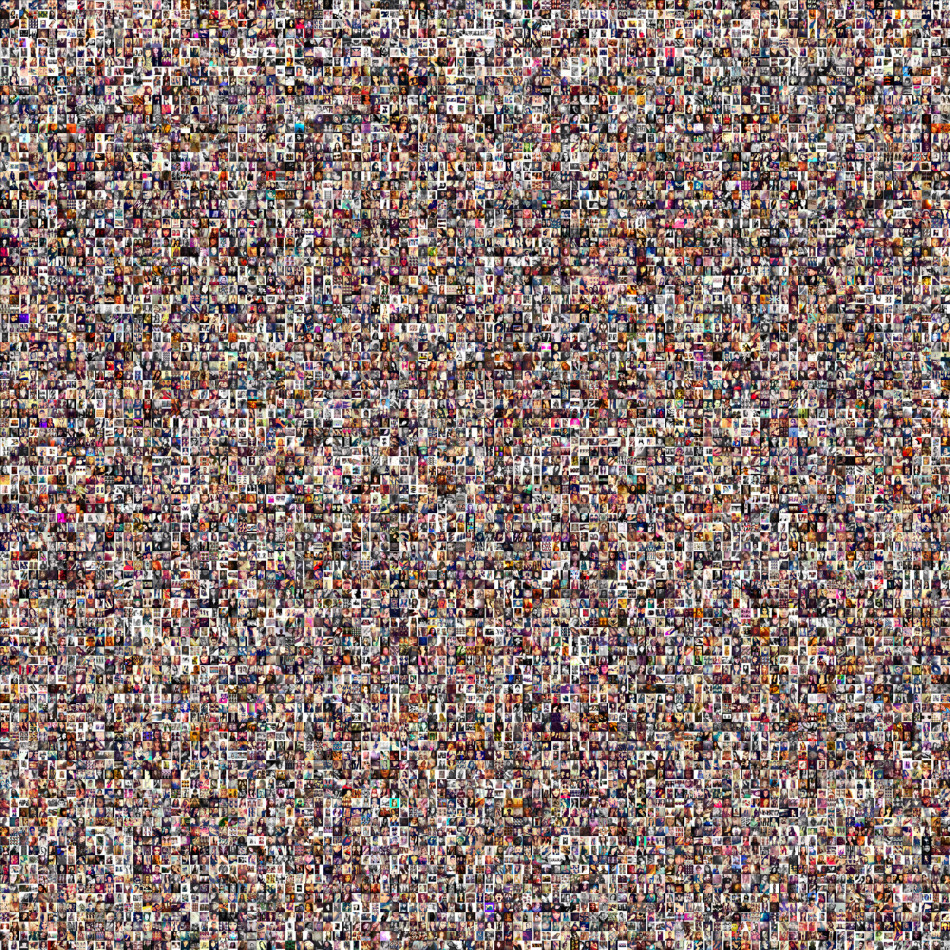Over the last month I’ve been collecting Selfies from Instagram. I set up IFTTT actions to grab anything posted to Instagram with the tag #selfie, #selfies or #selfienation and dump them in my Dropbox account. Every so often I went through these folders, removed the 20% or so of spam, miss-tagged and not-strictly-selfie images and was left with an ever increasing number of self portraits.
I’ve been putting them into grids, because that’s something I do when I have a large number of images that I’m trying to get my head around, but I also played with animation. One rather successful experiment was to align the eyes on 100 selfies. I made this into an 8MB GIF and a video.
This nicely illustrates the attraction of these images to me. Portrait photography is traditionally mediated by a 3rd party photographer. In the process of making the portrait, the primary relationship is between the photographer and the subject. The viewer of the photography is secondary, mediated by the photographer. What you are seeing in, say, a David Bailey portrait, is a product of that relationship. With a selfie, the photographer is the subject. The only human actors in this process are the person in the photo and the person looking at the photo.
That’s not to say this unmediated portrait is better or worse than the “traditional” way. It’s just different. (And it’s not strictly unmediated - the restrictions of the Instagram platform play an important role in the creative decisions made, but that’s a whole ‘nother issue to be explored later.)
This direct connection between subject and viewer really comes out in the eyes. While sifting through the thousands of selfies I realised I could immediately spot which ones were true selfies and which were photos taken by a 3rd party by looking at the eyes. The true selfies seem to look through the photo while the fakes look behind the camera. The true selfies are in complete control of the process while the fakes are trusting, or mistrusting, someone else. It’s this control and directness that makes the selfie so fascinating to me.
I’m now convinced this is going to be a major part of my work in 2014 so I’m not going to address the many other issues surrounding selfies - the gender politics of a genre dominated by young women, the inevitable denigration of the genre by media snobs, the paradox (or not) of a deeply individual mode of photography creating a distinct taxonomy leading to a vanishing of authoriship. All that can wait.
For now, here are my first 10,000 selfies in grid (click for bigger on Flickr) and video at 15 per second. I recommend making the video full screen and getting in close for the full effect.


The idea that selfies have become a genre is fascinating. I realise you have to focus on your aspect as an artist and photographer, Pete, but for me it throws up so many questions which all revolve around - why do people take selfies? Is it predictable from self-esteem or age group? Obviously there’s more female selfies than male.
At first I assumed that the subjects of each selfie would form a self-selecting sample of people with sufficiently high self-esteem to want to take the photo of themselves. But maybe not. Maybe, subjects who normally hate having their photo taken by someone else relishes the control of taking a selfie. Or maybe people with low opinions of their appearance love selfies because they can create an slat persona behind which they can far the camera. Or maybe it’s impossible to ever know.
I wondered whet you thought?
Damn auto correct! Was trying to say alter ego or alter persona…
Amazing collection! I collect and categorize twitter avatars among which are many (many, many) selfies, although I haven’t quite reached the 10,000 mark. Yet! A few examples from my website avadenticals.org:
http://www.avadenticals.org/categories/61.-headset
http://www.avadenticals.org/categories/40.-reclining-romeo
http://www.avadenticals.org/categories/23.-diagonal-girl
http://www.avadenticals.org/categories/95.-salute
http://www.avadenticals.org/categories/86.-fist
Well now! Very interesting!